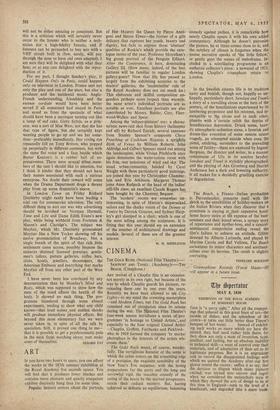IF you have two hours to spare, you can afford
the works in the 18,7th summer exhibition of the Royal Academy five seconds apiece. You will find that it produces fewer blushes and contains more pleasant and quietly competent exhibits discreetly hung than for some time.
Popular interest centres about the portraits
of Her Majesty the Queen by Pietro Anni- goni and Simon Elwes—the former of a glib delicacy that captures her youth, bcauty and dignity, but fails to express those 'abstract' qualities of Ruskin's which provide the cata- logue motto of the year. Professor Moynihan's . big group portrait of the Penguin Editors, After the Conference, is here, dominating Gallery III. (How many, indeed, of the best pictures will be familiar to regular London
gallery-goers? Now that life has passed so largely from the exhibiting societies to the dealers' galleries, the 'inadmissible' rule of the Royal Academy does not cut much ice.) This elaborate and skilful composition en- genders perhaps more 'respect than warmth; the same artist's individual portraits are as notable as ever. Excellent portraits are also contributed by Messrs. Buhler, Carr, Fleet- wood-Walker and Spear.
Among the 'subject-pictures' are: a charac- teristic news-reel shot from history (helicopter and all) by Richard Eurich; several canvases
from Stanley Spencer's composite Christ Preaching at Cookham Regatta; a sprightly Birth of Venus by William Roberts. John
Aldridge and Gilbert Spencer stand out among the landscapists, while Vivian Pitchforth once again dominates the water-colour room with his free, wet notations of wind and sky. The usual urban-romantics, headed by Carel Weight with three particularly good paintings, are joined this year by Christopher Chamber- lain and Eric Atkinson. Margaret Thomas joins Anne Redpath at the head of the ladies' still-life class; an excellent Claude Rogers has been bought by the Chantrey. Bequest.
The 'modern' rooms are somewhat un- interesting, in spite of Minton's shipwrecked
sailors and the chalky vision of the Domes of Venice by Derrick Greaves, and Sydney Harp- ley's girl• slumped in a chair, which is one of the most telling among the sculptures. It is fitting that this year \should see an extension of the number of architectural drawings and models. Several of these are of the greatest interest.
M. H. MIDDLETON










































 Previous page
Previous page